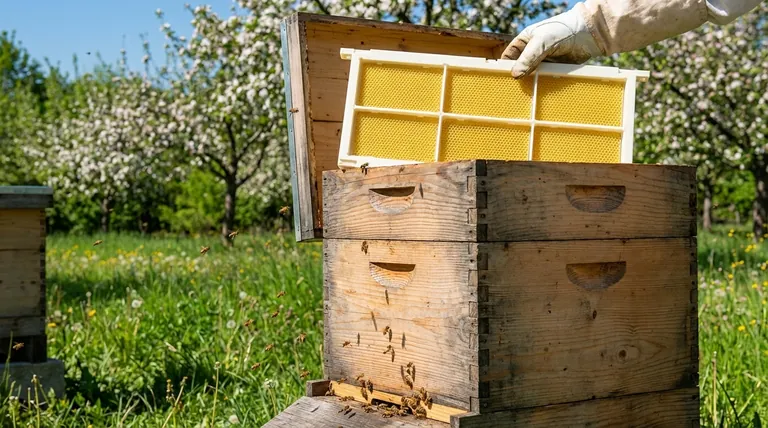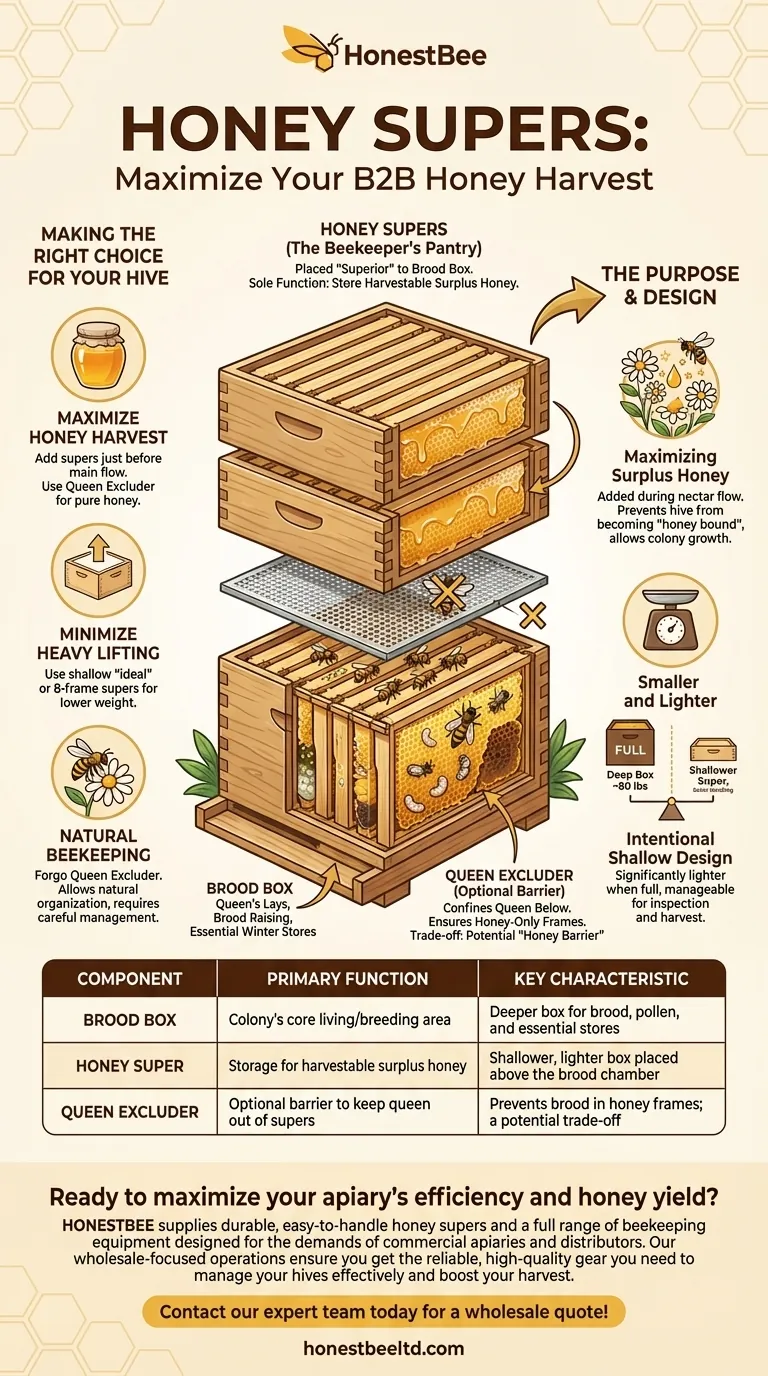In beekeeping, a honey super is a box containing frames that is placed on top of the main hive body. Its specific purpose is to provide dedicated space for honey bees to store surplus honey. This design allows beekeepers to harvest honey without disturbing the colony's primary living and breeding area, known as the brood chamber.
The core principle of the honey super is to create a clear separation between the bees' essential winter food stores and the beekeeper's harvestable surplus. It acts as a pantry, added during times of plenty and removed when it is full.

The Hive's Architecture: Brood Box vs. Honey Super
A modern beehive is a modular system. Understanding the function of its two primary components—the brood box and the honey super—is fundamental to effective hive management.
The Brood Box: The Colony's Core
The main, deeper boxes at the bottom of the hive make up the brood chamber or brood box. This is the heart of the colony.
Here, the queen lays her eggs, and the worker bees raise the young (the brood). The frames in this area will contain eggs, larvae, pupae, and the pollen and honey required to feed the developing bees.
The Honey Super: The Beekeeper's Pantry
The honey super is placed "superior" to, or above, the brood box. Its sole function is to collect excess honey.
Bees are instinctually driven to store as much honey as possible. By adding supers, a beekeeper gives them the extra space they need to store honey beyond what the colony requires for its own survival.
The Purpose and Design of a Super
The design of a honey super is intentional, built around the goal of efficient honey harvesting and the physical limitations of the beekeeper.
Maximizing Surplus Honey Storage
Supers are added to the hive during a nectar flow—the period when abundant flowers are producing nectar. This gives the bees the room to capitalize on this natural bounty.
Without this extra space, a strong colony could become "honey bound," filling all available cells with nectar and leaving no room for the queen to lay eggs. This can stifle colony growth and even trigger a swarm.
Why Supers Are Smaller and Lighter
Honey supers are purposefully built with shallower depths (e.g., 6-5/8" or 5-11/16") compared to the deeper brood boxes.
The reason is simple: weight. A deep box full of honey can weigh over 80 pounds, making it extremely difficult to lift. Shallower supers, when full, are significantly lighter and more manageable for the beekeeper to handle during inspection and harvest.
Understanding the Trade-offs: The Queen Excluder
To ensure the honey super contains only honey, many beekeepers introduce another component, which comes with its own set of considerations.
The Problem: Brood in Your Honey
If the queen bee ventures into the honey super, she may begin laying eggs in the frames. This is undesirable for the beekeeper, as it complicates the honey extraction process and reduces the purity of the harvest.
The Solution: A Barrier for the Queen
A queen excluder is a screen with openings large enough for worker bees to pass through but too small for the larger queen. When placed between the brood box and the honey super, it effectively confines the queen to the lower part of the hive.
The Downside: A Potential "Honey Barrier"
The use of a queen excluder is a trade-off. Some beekeepers believe it can slightly reduce the efficiency of honey production, as the barrier can slow down worker bees moving between the brood nest and the supers.
Making the Right Choice for Your Hive
How you use honey supers depends directly on your goals as a beekeeper.
- If your primary focus is maximizing honey harvest: Add supers just before the main nectar flow begins and use a queen excluder to ensure honey-only frames.
- If your primary focus is minimizing heavy lifting: Use only the shallowest supers (often called "ideal" or 8-frame supers) to keep the weight of a full box as low as possible.
- If your primary focus is natural beekeeping: You might choose to forgo a queen excluder, allowing the bees to organize the hive as they see fit, but this requires more careful management during harvest.
Ultimately, the honey super is the key tool that makes beekeeping a sustainable partnership between the colony and the keeper.
Summary Table:
| Component | Primary Function | Key Characteristic |
|---|---|---|
| Brood Box | Colony's core living/breeding area | Deeper box for brood, pollen, and essential honey stores |
| Honey Super | Storage for harvestable surplus honey | Shallower, lighter box placed above the brood chamber |
| Queen Excluder | Optional barrier to keep queen out of supers | Prevents brood in honey frames; a potential trade-off |
Ready to maximize your apiary's efficiency and honey yield?
HONESTBEE supplies durable, easy-to-handle honey supers and a full range of beekeeping equipment designed for the demands of commercial apiaries and distributors. Our wholesale-focused operations ensure you get the reliable, high-quality gear you need to manage your hives effectively and boost your harvest.
Contact our expert team today to discuss your beekeeping supply needs and request a wholesale quote!
Visual Guide

Related Products
- Professional 500g Sectional Comb Honey Frame System for Beekeeping
- Langstroth Honey Bee Box Hive Boxes for Different Depths
- Automatic Heat Preservation 6 Frame Pro Nuc Box for Honey Bee Queen Mating
- Inverted Squeezable Honey Jar with No Drip Flip Top Cap for Easy Pouring
- Twin Queen Styrofoam Honey Bee Nucs Mating and Breeding Box
People Also Ask
- How do you inspect honey frames? Master the 70-80% Rule for Healthy Hives
- Why might a customer look for shallow equipment in a store? To Reduce Weight and Enhance Hive Management
- What should be done if bees won’t use the honey super? Unlock Your Hive's Full Honey Production Potential
- How much honey can you get from one frame? Maximize Your Harvest with the Right Frame Size
- How long does it take for bees to fill a frame with honey? It Depends on These 4 Key Factors



















